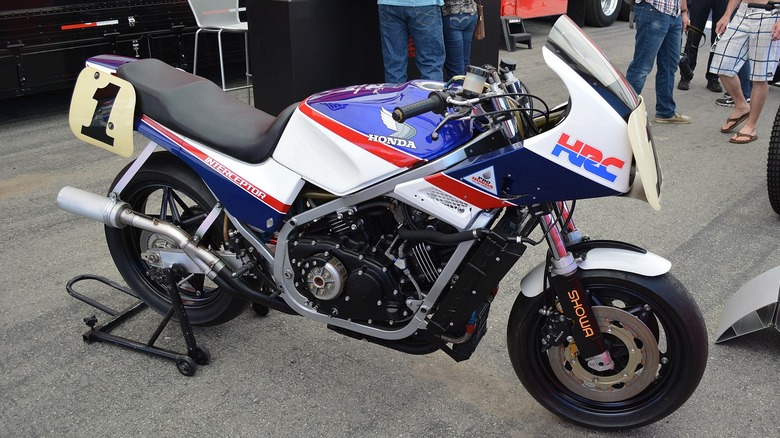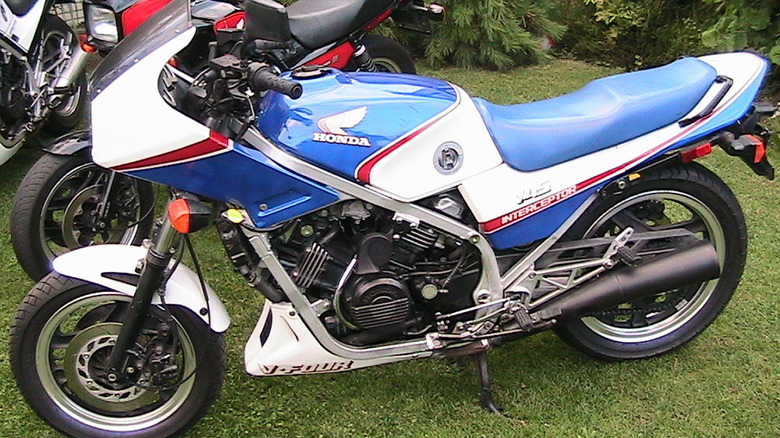The Stylish Honda Motorcycle That Still Turns Heads Today
In the early 1980s, change was coming to the American Motorcycle Association's Superbike Championship. The top dogs of the racing class were sporting 1,000 cubic-centimeter (1.0 liter) engines that could produce up to 150 horsepower, pushing the safe limits of the motorcycle frames, tires, and suspension that were tasked with harnessing that power. Subsequently, in 1983, the maximum engine displacement for the Superbike class was reduced to 750 cubic centimeters (cc).
Besides a smaller, less powerful engine, the Superbike racers also now had to share a frame and other components with production motorcycles that were available for the public to purchase. The process of selling a sufficient quantity of street-legal vehicles to qualify for a racing series is known as homologation and the bike that Honda had in mind to dominate the new 750 cc Superbike class was the freshly minted 1983 VF750F V45 Interceptor.
The VF750F Interceptor was massively different from the Honda racing bikes that preceded it. To start, it had a highly visible square-tube perimeter frame rather than conventional — and discreet — round tubing. But the most shocking change was its engine. Previously, Honda had been racing with air-cooled inline-four-cylinder powerplants. Not only was the VF750F water-cooled, but it also used a V-4 design that was derived from the brand's Magna and Sabre cruising motorcycles. Victory in the Superbike Championship would evade Honda in 1983, but the brand would make up for that shortfall by winning five consecutive years in a row from 1984 to 1988 with its VF750F.
[Featured image by Daniel Hartwig via Wikimedia Commons | Cropped and scaled | CC BY 2.0]
It was an unexpected sales success
As required by the homologation rules, the street bike that hit Honda dealership showrooms was nearly indistinguishable from its racing counterparts. The V4 engine produced 86 horsepower, good for a standing quarter-mile time of 11.4 seconds. It would be a shame to only drive this bike in a straight line, though, because it also featured a fully adjustable Showa suspension with a beefy 39mm anti-dive front fork supporting a radically small 16-inch front wheel for enhanced cornering.
One final racy feature was the Interceptor's "slipper clutch" which partially disengaged the engine under heavy braking to prevent wheel hop — a first ever for a production motorcycle. At first, Honda only intended to produce enough VF750F Interceptors to qualify for racing, but the bike turned out to be a runaway sales success. This, in spite of a relatively high price due partly to tariffs on large-displacement imported bikes that were intended to protect American manufacturer Harley-Davidson.
[Featured image by Nedhills via Wikimedia Commons | Cropped and scaled | CC BY-SA 3.0]
The Interceptor was tarnished by reliability issues
Honda capitalized on the VF750F's unexpected popularity with a series of accessories such as a rear seat cowl with matching paint that closely mimicked the race bikes, which only had a single seat. Engine crash bars were also available, which protected the engine from damage in case the bike made contact with the ground. More pedestrian items such as a cover and luggage rack were also marketed.
As riders started to accumulate mileage on their Interceptors, concerns over reliability surfaced, particularly with the engine's camshafts. Initially thought to be an oiling problem, Honda later discovered excessive clearance between the camshafts and the bearings that supported them, leading to premature wear. Although the bikes were recalled and new camshafts installed, the incident was still a black mark against Honda's legendary reputation for reliability.
In spite of its strong sales, the VF750F Interceptor was replaced with the VFR750F in 1986. The bikes shared some DNA to be sure, but the full-fairing VFR750F was more of a sport-tourer than the Interceptor's full-on race personality. Today, the VF750F Interceptor is an affordable classic, with prices hovering around $3,000 for a good-condition example. Ironically, that's less than the $3,498 that the bike cost new, in spite of 40 years worth of inflation.

